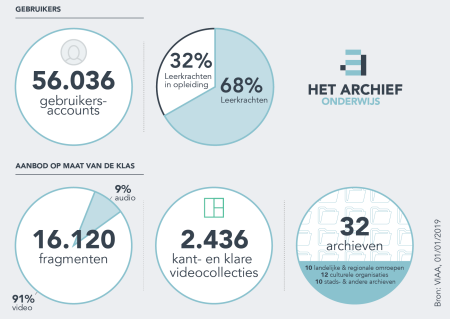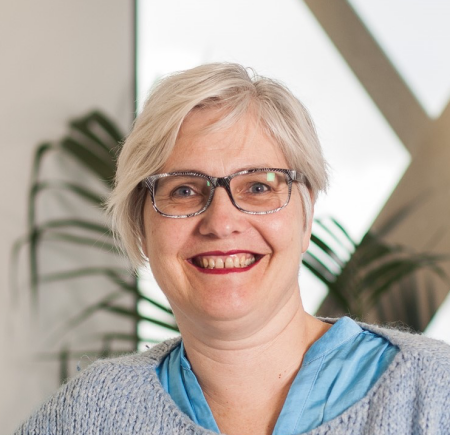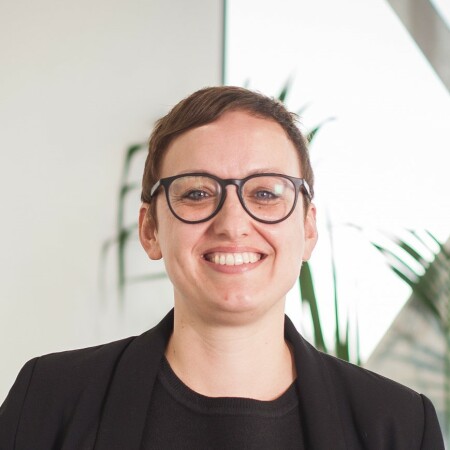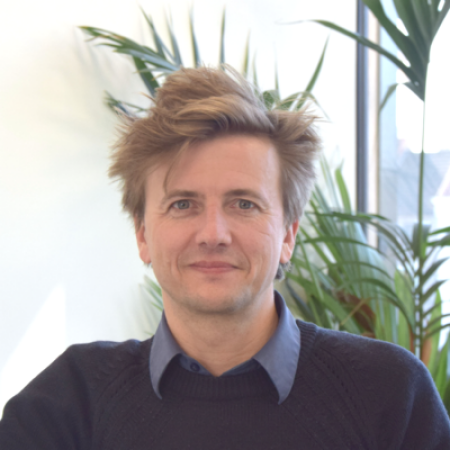2018 in brief
New image and audio content is produced every day. Whether it’s beautiful, exceptional or run-of-the-mill, it captures the present and past – and that’s why we want to preserve it in the best way possible, and distribute it further. In 2018 we again took a few significant steps forward, which we summarise for you here.
This year we can look back on five years of VIAA, and the future looks very exciting too,’ says director Nico Verplancke. ‘With PACKED and Lukas together under one roof, we can ensure our services keep going from strength to strength.'

Our sixth year of operation in six highlights
20 February: We celebrate our fifth anniversary with partners, stakeholders and colleagues in the Belgian Comic Strip Center in Brussels. A good time to look back on five years’ hard work, great moments and excellent results.
5 March: Our Digital Video adventure starts with extensive research into details about carriers. Converting digital signals is a new challenge for our team.
14 March: Following thorough preparations in 2017, we launch Catalogus Pro. Our content partners can now discover what’s in each other’s archives (and the VIAA archive system), and watch or listen straight away.
31 March: We finish importing the existing (digital) VRT archive as planned. This accounts for a total of 4 PB since July.
28 September: Sven Gatz, Flemish Minister for Culture, announces that VIAA will take over PACKED and Lukas operations from 2019. This means we have three months to prepare the merger administration. Exciting months for the three organisations.
27 October: We launch knowyourcarrier.com (kenjedrager.be) on World Day for Audiovisual Heritage. You can use this new site to find out what audiovisual carriers you have in your possession, and read tips for preserving or digitising them.
What did we achieve in 2018?
2018 was a year of change: we relocated, launched two platforms and received news of an impending merger. But what did this mean for you as one of our platform users, as a partner or stakeholder?
For you as a user
Anyone who has unidentified tapes, discs or cassettes stored in their attic can turn to knowyourcarrier.com (kenjedrager.be) since 2018. This website can help you discover what images and audio you have in your archive, and provides tips for good preservation and digitisation. Over recent years we’ve gathered lots of knowledge in various digitisation projects, which we’ve compiled for you here.
As a teacher, in 2018 you were also able to use The Archive for Education to support your lessons with videos and audio clips. Our number of users grew by 20% to 56,000 accounts. Among other things, teachers and teachers-to-be gained access to KLAAR – an online programme from VRT NWS in collaboration with VIAA and Smartschool that brings complex and topical issues into the classroom in plain language. We also contributed to the updated News in the Classroom.
Users of the educational platform were able to join 37 regional workshops and requested 66 workshops. Our collaborations with five educational publishers were evaluated positively at the end of 2018. A good thing – as this means we were able continue our partnerships with Averbode, Die Keure, Pelckmans, Plantyn and VAN IN! You can see more figures below:

I’m pleased that we’ve been able to present such positive growth figures for The Archive for Education together with our team, and can continue to bring current affairs into the classroom,’ explains Karen Vander Plaetse, Marketing and Interaction Manager. ‘As well as developing a handy tool that anyone can use to identify their audiovisual treasures, we also took our first steps in linked data, with newspapers from the News from the Great War collection.’

In 2018, we enriched the News from the Great War newspaper collection with linked data in The Archive, our open archive for the general public. This meant we were able to link the names of casualties in the List of Names from the In Flanders Fields Museum to our wartime newspapers. Don’t know what this means? We explain in fine detail in three tech blogs. You can even use it for yourself.
Visit viaa.be to watch a few gems of videos from our content partners. That’s where we’ve published video clips from times gone by that we simply couldn’t deny you. What do you think about this holiday with rounded corners, or this magical home video? We also shared this and other VIAA news in four newsletters.
In order to do this with respect for your privacy and personal data, we conducted thorough research into the needs and priorities for the GDPR legislation within VIAA. This resulted in a new cookie and privacy policy, so that new permissions could be requested for sending out newsletters where necessary.
For you as a partner
At the end of 2018, 151 content partners were entrusting us with their audiovisual content. To keep them all up to date with our methods for digitising, preserving and re-using this content, we organised eight workshops and a partner event in 2018, as well as sending various partner newsletters and direct mailings.
Our collaborations with partners are very important for us,’ says Debbie Esmans, VIAA’s Policy and Strategy Manager. ‘Informing them about our work and plans, involving them in our projects and teaching them about our tools and platforms is something that we try to do every day. And we had seven new content partners to do this for in 2018!’

Our diligent account management team went on several site visits and organised intake interviews with our new partners to ensure all this ran smoothly.
We digitised
Our latest figures show that we converted some 72,000 carriers into sustainable file formats in 2018.
Since 2013 we’ve digitised over 400,000 carriers of some 40 different types,’ says Brecht Declercq, Digitisation Manager. ‘These are impressive figures, also from an international perspective, even if we say so ourselves.’

Two international trainees helped us prepare the digital transfer of two interesting and challenging types of carrier: Digital Video formats and optical discs such as CD and DVD(-R).
We’re continuing to digitise quarter-inch audio tape, Betacam SX, VHS, vinyl and shellac records, and film affected by vinegar syndrome.
We successfully completed the digitisation of 22 rare carrier types.
An additional amount of VCR was also digitised.
The audio cassette, U-Matic and Betacam SP projects were extended.
You can find more digitisation figures from 2018 here.
Digitisation is not something that we do on our own. Our partners registered almost 85,000 carriers last year – that’s almost 400 per workday on average! The carriers then go to the digitisation company that’s been selected following a public tender procedure. You can find those dossiers here. We hope this can be a useful starting point for other heritage institutions and interested digitisation companies – both nationally and internationally.
We archived
2018 was another year with lots to be proud of. If I were to pick out a couple of highlights, I’d say the content in our archive system grew by 30% – the result of great efforts all across the organisation,’ says Matthias Priem, Archiving Manager. ‘I’m also very proud of our collaboration with the Museum of Industry. They archived their digital collection with us and – partly thanks to our infrastructure – immediately made it available on their new website.’

Content amounting to 2.5 PB was archived in 2018. That’s 2.5 million GB or 2.5 billion MB – compare that figure with your first MP3 player! This meant our content partners had a total of 10.5 PB stored in our archive system on 31 December 2018. We can attribute this growth to three sources. Firstly, the content that we digitise for our partners enters the VIAA archive system, which accounts for around 100 TB each month (this was mainly VHS, film and Betacam in 2018). Secondly, we have the VRT content – we finished importing the existing VRT archive in March (240 TB), and newly produced content is also being imported every day (around 100 TB per month). A third source is the influx of born-digital content. This is content that our content partners have as digital files, but which is imported in the VIAA archive system for storage and preservation.
In 2018, we also ran a few pilot projects to gain insights into how digital collections are currently stored by our content partners. This laid the foundations for scaling up our operations by providing tools, setting up a project structure and approach, and designing a training course for participating partners. This influx takes up a large share, especially in absolute number of items. In 2018 our archive grew from 3 million items up to almost 4 million. 897.000 of these stem from digital born collections. Among other things, we also set up a pilot project for the daily influx of video content from the new Museum of Industry, the k.ERF cultural heritage body for their newspaper collection, and regional broadcaster Focus WTV. You can find more archiving figures here.
We made content available
In order to provide our content partners with access not just to their own archive, but also to their colleagues’ archives, we launched Catalogus Pro in March. Partners can use this platform to access each other’s audiovisual content, ask each other questions, broaden their own audiences, and further optimise their archive and collection operations. Content partners can request their own account from VIAA.
VIAA content partners can of course also use the digitised content they have stored at VIAA for their own purposes. This is how the new Museum of Industry uses its image and audio content stored by us on its website, for example. So it doesn’t just sit in our archive system, but can also get out into the big wide world.
How did we do this?
We didn’t hire any new employees at VIAA in 2018, apart from to replace departing colleagues. We’re moving mountains with our 23 permanent employees (head count, not FTE) and employees on fixed-term contracts. We cannot thank our trainees, volunteers and consulting teachers enough for their contributions. The merger in 2019 will add more motivated souls, but also broaden VIAA’s scope of tasks.
Fortunately, in April we took the decision to relocate to a bigger building, so everyone still has somewhere to sit. We moved into our new offices on Kleindokkaai, close to Ghent Dampoort, in September. With more room at a location closer to the station, we’re fully ready for new workshops and training courses.
2018 was also the year when VIAA worked hard on its strategic five-year plan. We’re re-working this plan in 2019, partly in light of the merger with PACKED and Lukas, although we can continue to build on the work done in 2018. We also worked on VIAA’s statutory recognition in 2018, and this led to approval of the management agreement between the Flemish government and VIAA in March 2019 – a good reward for the work done over recent years.
The resources needed to carry out our tasks
Nothing comes from nothing. VIAA has received grants from the Flemish government’s departments for Culture and Education to enable the digitisation, storage and preservation of these thousands of carriers at three locations, and accessibility via various platforms. In 2018 these grants totalled €4,565,182. An additional amount of €41,066 was added to this thanks to the cost contribution from content partners, with a further €17,569 for services that don’t fall within the scope of our collaborative agreements with content partners.
One significant expenditure is the cost of personnel, which amounted to €1,795,733. The three cornerstones of VIAA’s operation are also significant: digitisation cost €1,512,221, archiving €904,932 and interaction €364,116. Expenditure for marketing and communication totalled €73,121. An investment of €86,813 was made for the Catalogus Pro platform and for reporting and integration. After accounting for provisions, financial costs, incomes and VAT, VIAA achieved a limited loss of €3,879.
Full speed ahead
We can look back on 2018 with great satisfaction. A lot of successful work was done and plans for 2019 have already been made. It will be a year of full speed ahead, with three organisations and a highly motivated team.
Do you want to stay up to date with us? Then follow us on Facebook, LinkedIn and Twitter, and subscribe to our newsletter.
